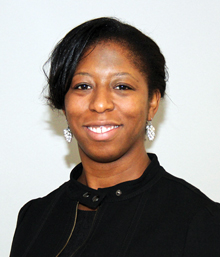Being a scientist is not enough for Ticora Jones: “The technology of what you do is only one part of a much broader conversation,” she says. She is engaged in that conversation as the creator and division chief of the Higher Education Solutions Network (HESN) at the United States Agency for International Development (USAID). The network pairs universities working on global development challenges—like food security, climate change, health, and poverty—with organizations and funding to bring solutions to the people who need them. “There’s a lot of ingenuity around the world,” she says. “But the opportunities people have to tap into it are not evenly distributed.”

Creating opportunity for others is a recurring theme for Jones. She cofounded the Black Women’s Alliance as an undergrad at MIT, where she majored in materials science and engineering. “Often we had been the only black women in an AP physics class, living a life of being the only one for a really long time,” she says. “When you find people who have had similar experiences, that kind of camaraderie is phenomenal.” After deferring grad school for a year to teach middle school, Jones began doctoral studies in polymer science and engineering at UMass Amherst, where she cofounded the Graduate Education Career Development Initiative to help graduate students build skills and find jobs outside the usual academic track. She earned her PhD in 2006.
Jones spent a year as a legislative fellow on Capitol Hill, advising Senator Russell D. Feingold of Wisconsin on energy and environmental issues. That taste of life as a scientist in government led her in 2011 to USAID, where she launched HESN the next year. Since then, the network has supported hundreds of projects, including a community-based radio program recorded on a cell phone and broadcast to other phones, created by university students in Uganda; a company to distribute clean birthing kits, started in India by International Development Design Summit.
Jones, who lives in Washington, D.C., enjoys traveling and salsa dancing. In April, she gave an impromptu keynote speech at MIT’s Scaling Development Ventures conference when her boss was called away. “Seeing the beaver, having a photo op with my brass rat in the Infinite, was trippy,” she says of her campus visit. “I was appreciating all the kinds of people that go to MIT. There’s a desire for excellence but also a knack for the unorthodox. Keeping those things alive in your life—that’s important.”
Keep Reading
Most Popular
Large language models can do jaw-dropping things. But nobody knows exactly why.
And that's a problem. Figuring it out is one of the biggest scientific puzzles of our time and a crucial step towards controlling more powerful future models.
The problem with plug-in hybrids? Their drivers.
Plug-in hybrids are often sold as a transition to EVs, but new data from Europe shows we’re still underestimating the emissions they produce.
How scientists traced a mysterious covid case back to six toilets
When wastewater surveillance turns into a hunt for a single infected individual, the ethics get tricky.
Google DeepMind’s new generative model makes Super Mario–like games from scratch
Genie learns how to control games by watching hours and hours of video. It could help train next-gen robots too.
Stay connected
Get the latest updates from
MIT Technology Review
Discover special offers, top stories, upcoming events, and more.